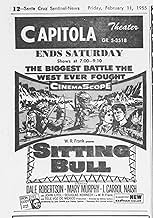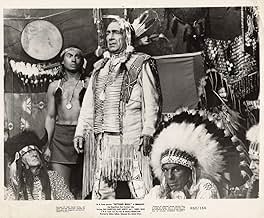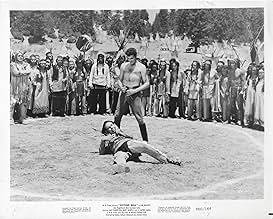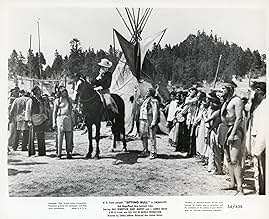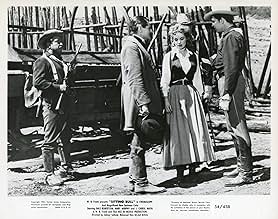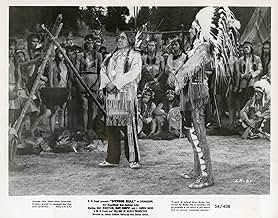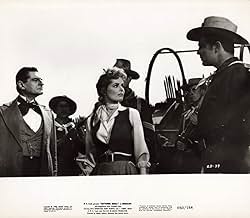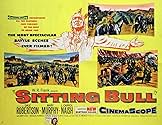Ajouter une intrigue dans votre langueA cavalry officer sympathetic to the wronged Sioux fixes a meeting between Chief Sitting Bull and President Grant but a dishonest Indian Agent and a hateful General Custer test the Sioux's p... Tout lireA cavalry officer sympathetic to the wronged Sioux fixes a meeting between Chief Sitting Bull and President Grant but a dishonest Indian Agent and a hateful General Custer test the Sioux's patience, threatening to derail the peace-talks.A cavalry officer sympathetic to the wronged Sioux fixes a meeting between Chief Sitting Bull and President Grant but a dishonest Indian Agent and a hateful General Custer test the Sioux's patience, threatening to derail the peace-talks.
- Charles Wentworth
- (as Bill Hopper)
- Webber - Indian Agent
- (as Tom Brown Henry)
- White Cloud
- (uncredited)
- Trooper Foster
- (uncredited)
- Young Buffalo
- (uncredited)
- Trooper
- (uncredited)
- Capt. Swain
- (uncredited)
Avis en vedette
But the "Bottom-Line" is that Most Movies are Made as Entertainment with a Profit Motive.
So Historical "Facts" Aside, as an Entertaining Piece of an Early Cinemascope Film (the first Independent) In the First-Half of the "Decade of the Western",
You Could Do Much Worse than this Nobly Intended Movie about the Sioux Chief "Sitting Bull",
His Constant Battles with "Forked-Tongue" Treaties and the General Inhumane Treatment of Prisoners,
Leading Up to the "Battle of Little Big-Horn" and Custer's Last Stand.
Playing Fast and Loose with some "Facts" is a Consideration to Make the Movie Box-Office Friendly.
But the Film Deserves Credit for Bucking the Trend of "White-Man Wins Called Victory...Indian Wins Called a Massacre" and Taking a Liberal Other-Sided Approach.
In the End it is Not Guilty of Over-Indulging the Re-Writing of History and Shows Respectable Behavior on Both Sides.
The Casting is Weak but the Story and the Epic Battles are Well Staged, Engaging, and Somewhat Informative.
All Things Considered...A Fine Film and Definitely...
Worth a Watch.
J. Carrol Naish is Sitting Bull and Dale Robertson, the cavalry man who's on the side of the Indians. Its view of history may be a little off the wall but it's a perfectly accessible 'Cowboys & Indians' picture which makes you wish it were better written and acted; the on-again-off-again love affair between Robertson and Mary Murphy is frankly embarrassing. Not a great western, then and maybe not even a good western but as Dilys might say, not a bad one either.
The story revolves around an officer who has been demoted. Bob Parrish (Dale Robertson) is not your typical cavalry officer, as he thinks that the American government should respect and treat the natives much better than they do. As he put it, 'they just want to live and raise their families'. But folks like General Custer and the rest give him a lot of guff and they seem to follow the old axiom, 'the only good Indian is a dead Indian'. What's to become of him and his mission to work WITH the natives instead of AGAINST them?
It is ironic that not only did Iron Eyes Cody appear in the film as Crazy Horse, but he was the consultant to the production about native culture. Only later in life did folks learn that Cody (the most American Indian looking guy on the planet) was actually an Italian!! But you can't blame the film....at the time everyone thought Cody was exactly what and who he pretended to be! But he and the filmmakers STILL got so much right in this one...and the movie holds up far better than most from the genre*. Well worth seeing and an excellent picture in so many ways.
*For the worst possible depiction of this same story, try "They Died With Their Boots On". While the cast was incredibly impressive (with Errol Flynn and Olivia de Havilland), the facts are pretty much tossed out the window and Custer is depicted as a great man...not the incompetent he actually was.
This exciting movie contains western action , romance , shoot-outs and spectacular battles . The yarn was shot outside of Mexico City and in the Churubusco Azteca studios . Washed-out print , the film needs urgently a perfect remastering . It appears as a technical adviser and designer Indian costumes , a secondary actor named Iron Eyes Cody , usual player as Indian roles (Great Sioux Massacre , A man called Horse) , though with Sicilian origin . The motion picture was regularly directed by Sidney Salkow .
The film is a fiction , but partially based on real events . The reality happened in December 1873 when the Commissioner of Indian Affairs directed all Sioux bands to enter reservations by the end of January 1876 or be declared hostile . Many bands of Sioux did not meet this deadline and were attacked by US troops . Crazy Horse and his Oglala people moved north to join forces with Sitting Bull , by the spring of 1876 some 3000 Teton Sioux and Northern Cheyenne warriors had assembled at Sitting Bull's camp in the valley of the Little Big Horn in Montana. On 25 June 1876 Crazy Horse and other war chiefs led the allied warriors against General Custer and his seventh Cavalry , Custer and all the man under his direct command were killed . This victory , however , brought relentless retaliation from the army and Sioux were scattered . Sitting Bull and his followers fled to Canada and stayed there until July 1881 , when he returned to the US and surrendered at Fort Buford , Montana . After he was placed on a South Dakota reservation . For a year Sitting Bull went a tour with Buffalo Bill's Wild West Show . He continued to regard himself as chief of his people and he earned the enmity of an Indian agent . On 25 December 1890 , Indian policemen went to take the chief , his followers tried to prevent this and in the struggle he was shot dead .
There's a traditional romance thrown into the mix, between a General's daughter (MARY MURPHY) and Robertson, with rival suitor WILLIAM HOPPER as another man interested in Murphy. J. CARROL NAISH is Chief Sitting Bull, who wants peace and refuses to put on his war paint although some members of his tribe are anxious to fight some of the white men's injustices. DOUGLAS KENNEDY is flamboyant and seriously miscast as the yellow-haired General Custer of the 7th Cavalry.
It's handsomely produced in outdoor settings that look authentic, but the stilted dialog is handled indifferently by a lackluster cast of players. DALE ROBERTSON gives a leaden performance in the major role and he doesn't get much help from WILLIAM HOPPER or MARY MURPHY, who in real life, married Robertson after this film. Their chemistry on film fails to register and her motivations throughout are sketchy, to say the least.
A major plot development has President Grant helping Robertson when he is condemned for helping Chief Sitting Bull and there are a few other subplots before we get to the battle at Little Big Horn. Robertson's compassion for the redskins almost lands him in big trouble toward the end, until Chief Sitting Bull intercedes just before he's about to be executed for treason by a firing squad.
Good western should have been much better but is marred by dull performances and uninspired direction of Sidney Salkow. The director unwisely allowed few close-ups of his cast throughout the film, depending solely on medium shots for most of the scenes, probably because he was new at the CinemaScope process. Since most of the cast underacts considerably, this is a real drawback in the more intimate moments.
Le saviez-vous
- AnecdotesThe film was shot outside of Mexico City, and star Mary Murphy caught "Montezuma's Revenge" and was very ill throughout the six-week shoot. Most of her scenes are relatively brief, possibly because of this.
- GaffesIn many of the scenes the women are obviously men.
- Citations
Sitting Bull: I have wanted peace. I have prayed for peace. There have been battles. But when the white soldiers win a battle, they call it victory. When the Indians win, they call it massacre.
- Générique farfeluDuring the opening titles, the film's 'Technical Advisor and Indian Costumes' is credited to 'Iron Eyes Cody' who is also parenthetically credited as being a '(Famous T.V. Star)'.
- ConnexionsFeatured in Le massacre des sioux (1965)
- Bandes originalesGreat Spirit
Music and Lyrics by Max Rich
Meilleurs choix
- How long is Sitting Bull?Propulsé par Alexa
Détails
Box-office
- Brut – États-Unis et Canada
- 1 500 000 $ US
- Durée1 heure 45 minutes
- Mixage
- Rapport de forme
- 2.55 : 1
Contribuer à cette page



